Athenian pottery traveled far, and often in quantity. The limits of distribution range from Spain through central Europe, South Russia, Persia, and along the North African coast. On some of the more receptive sites, especially in Italy, we may judge the results of this trade not merely from sherds but from hundreds of complete vases. These vases, and even small fragments, are easy to recognize, and their shapes and decoration have been studied in such deter that dating is closer than for any other artifact of the period, while even potter and painter can often be identified, sometimes named. Through most of the period the Athenian studios had no trading rivals in decorated pottery in the Mediterranean world. Their products seem to offer an almost ideal subject for a study of trade, but can we do more than list and number finds? Can we learn about the mechanics of trade? Does it reflect wider historical issues?
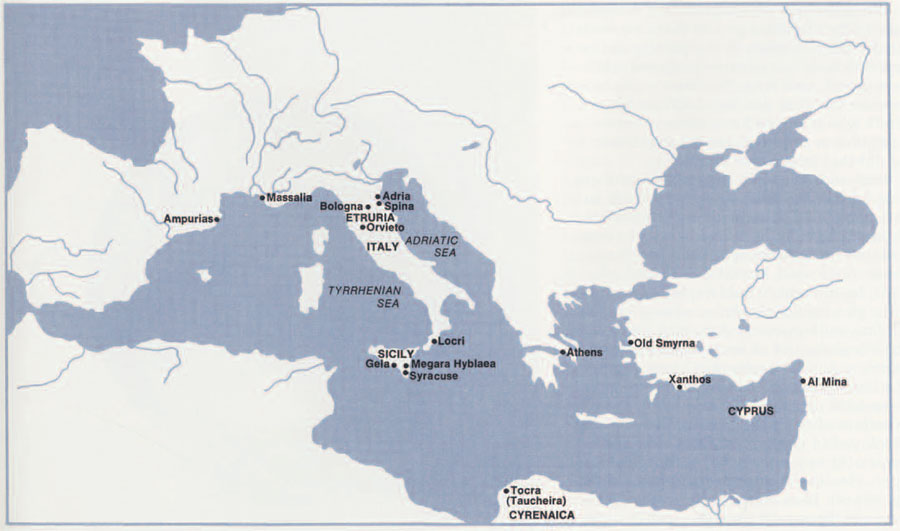
Our sources and the possibilities they offer are, in fact, very limited, and I fear that the general tenor of this paper is likely to be pessimistic. Here I shall try simply to indicate what the sources are, how they might be used, and what some of their limitations appear to be. I make no claim of originality in this, but simply offer food for thought, and perhaps some answers to those who expect too much of us.
In the extant works of ancient authors the pottery trade is barely mentioned. This is, at any rate, a sorry source for information about trade, and we learn so much about the trade in grain in the later Classical period only because of legal disputes over bottomry, which occasioned surviving lawcourt speeches. We hear as little about trade in metals (other than precious metals] as about trade in pottery, yet for earlier periods we have become accustomed to believing that metal trade was vital and politically influential, and this could hardly have been less true in the Classical period.
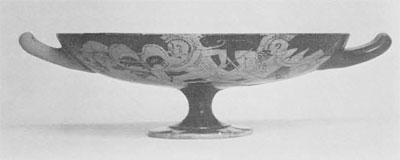
Museum Object Number(s): MS3499
We can learn something of the organization of the Potters’ Quarter in Athens itself from study of the vases, and a useful survey of this evidence appeared in 1972 in the late T. B. L, Webster’s Potter and Patron in Classical Athens, which is based on the lists in Beazley’s great works: but this is not trade. Graffiti (scratched) and dipinti (painted) on the vases offer an opportunity for closer inspection of the way the pottery was handled for the export market, a study revived now by A. W. Johnston’s forthcoming book which replaces Hackl’s study of 1909. Graffiti also tell us something about prices and it might seem possible to calculate with some accuracy the cash value of the export trade, Estimates of the proportion of the whole original production which has survived and been identified in excavations are bound to be very imprecise and a figure of one per cent may be optimistic. Beazley notes that some Athenian potters of the Archaic period were wealthy enough to make expensive offerings on the Acropolis, and in the Classical period there were no doubt some tycoons in the pottery industry, but their wares were progressively less prized, and from the known prices it seems clear that this was unlikely to be a trade which would have attracted state attention or required special regulation, as did that in grain or silver.
Professor Webster suggested that there was a brisk second-hand export trade in Athens, aimed principally at Etruria. He thought that whole dinner services were ordered for specific symposia and that these, once used, would be shipped off. This, he thought, would explain the appearance on vases of the kalos names, congratulating contemporary Athenian youths on their beauty, and of no interest or significance to any Etruscan purchaser. True; but the inscriptions are discreet and may not have been designed for more than the admirers of the pottery before it was sold, displayed in shops or studios near the Agora. At any rate, it can hardly have applied to the majority of the vases chosen for export, If so many of the vases were bespoke, so surely were the scenes upon them. But no intelligible pattern of choice of scenes seems to depend on, for instance, halos names. The evidence points rather to the artist as arbiter of the scenes he painted, since we can easily detect individual preferences or approaches to myth, and even changing interests in the work of a single artist, and the occasional bespoke vase readily declares itself. That there was some sort of second-hand trade is perfectly possible. We have yet, however, to recognize or discover the evidence for how it was operated.
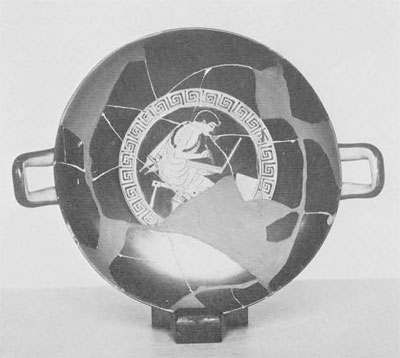
Museum Object Number(s): MS4842
It is sometimes observed that particular shapes, or particular scenes, or the works of a particular studio may be unusually well represented on a site, implying a special demand or some deliberate direction of trade. The phenomenon of the “export model” is best observed in 6th-century Athens, in the workshops of the Tyrrhenian amphorae and of Nikosthenes, where vases were produced with a style of decoration designed to appeal to the customer, and on some shapes which were familiar to him though never to the Athenian, In the Classical period the only specialist shape production of this sort might be the rhyton in the form of a figure vase, which has its origins in the East, but they do not seem to have been destined especially for the Eastern markets (such as they were] and more probably they ape finer works in metal. Where batches of a single shape are found, and no local explanation is readily forthcoming—such as suitability for cult or votive use, or where batches from a single workshop are found, we may be observing conduct of the bulk trade in decorated pottery which could, through the accidents of demand or availability, bring one consignment at one time to a local buyer. This is more easily discerned in the remoter consumer areas where trade may have been on a less regular basis: it is, for instance, readily observed at the remote colony of Taucheira in Cyrenaica in the 6th century. But this gives us no grounds for believing that all pottery trade was conducted in batches of single shapes like this, since there are graffiti on vase bases which detail the numbers and prices of batches comprising several different shapes, not always sharing any common or related purpose.
For the question of choice of subject matter for export we have Keith De Vries’ recent interesting observations about the distribution within the Persian empire of Athenian scenes showing Greeks fighting Persians, and in the 4th century there are the numerous scenes of Arimasps and griffins appropriately dispatched to the Black Sea region. This is a fruitful field for research in both the Archaic and Classical periods, but I have the feeling that we should allow ourselves to be impressed only by mass exports of particular scenes which are relatively poorly represented at home, or by single vases which were clearly bespoke for a particular place or occasion. This is not the only area of Greek vase research where enthusiasm can be indiscriminate and self-defeating.
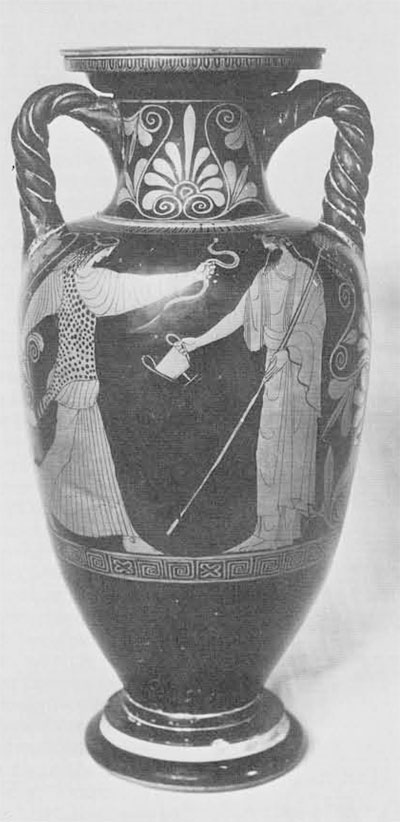
Museum Object Number(s): MS5466
I have been wary, so far, in my use of absolute numbers, proportions and statistics, but in such a study they cannot and must not he shunned; indeed the economic historian or archaeologist of other periods may chide the classicist for apparent innumeracy. Unfortunately the advanced statistics deployed so confidently—though who can say how accurately or with what historical truth—by archaeologists of other periods, are probably not for us, despite the apparent wealth of our material and our assumed ability to date it closely. Far too many factors weigh against any high degree of confidence in the samples we have to use. Classical life cannot be quantified as easily as a culture represented, and quote fully represented, by assemblages of a relatively few types of stone tools and middens of animal bones. How ,do you sample a Classical site—its houses, sanctuaries, cemeteries? Are all these sources important, and are all equally important? And on how many Classical sites do we have absolute knowledge of all these sources? Lucky the site with a short history—Old Smyrna, Megara Hyblaea! At least, they were not overbuilt for centuries afterwards and there is some chance of a fairly full understanding of their main periods and the artifacts belonging to them. The very sophistication of Classical society, which makes it such an absorbing study, militates against the possibility of our knowing it as fully as we could wish.
There are at least two areas of study in Athenian pottery trade for which provisional statistics can be prepared which might prove of historical value. One is the volume of trade to a site in successive periods, compared with the record of other sites; another is the distribution of shapes. The distribution of scenes might be studied in the same way, but I dwell on the other two since it is possible to produce for them rough charts from which we can judge whether the whole exercise seems worth the effort, and with which we can speculate about the probable sources of error. The identification and acknowledgment of these limitations seems to me vital in such work. They introduce variables which it is impossible to quantify and it is only because the results nevertheless do seem plausible though not always deeply significant, that the exercise may seem worth pursuing by others, in greater detail.
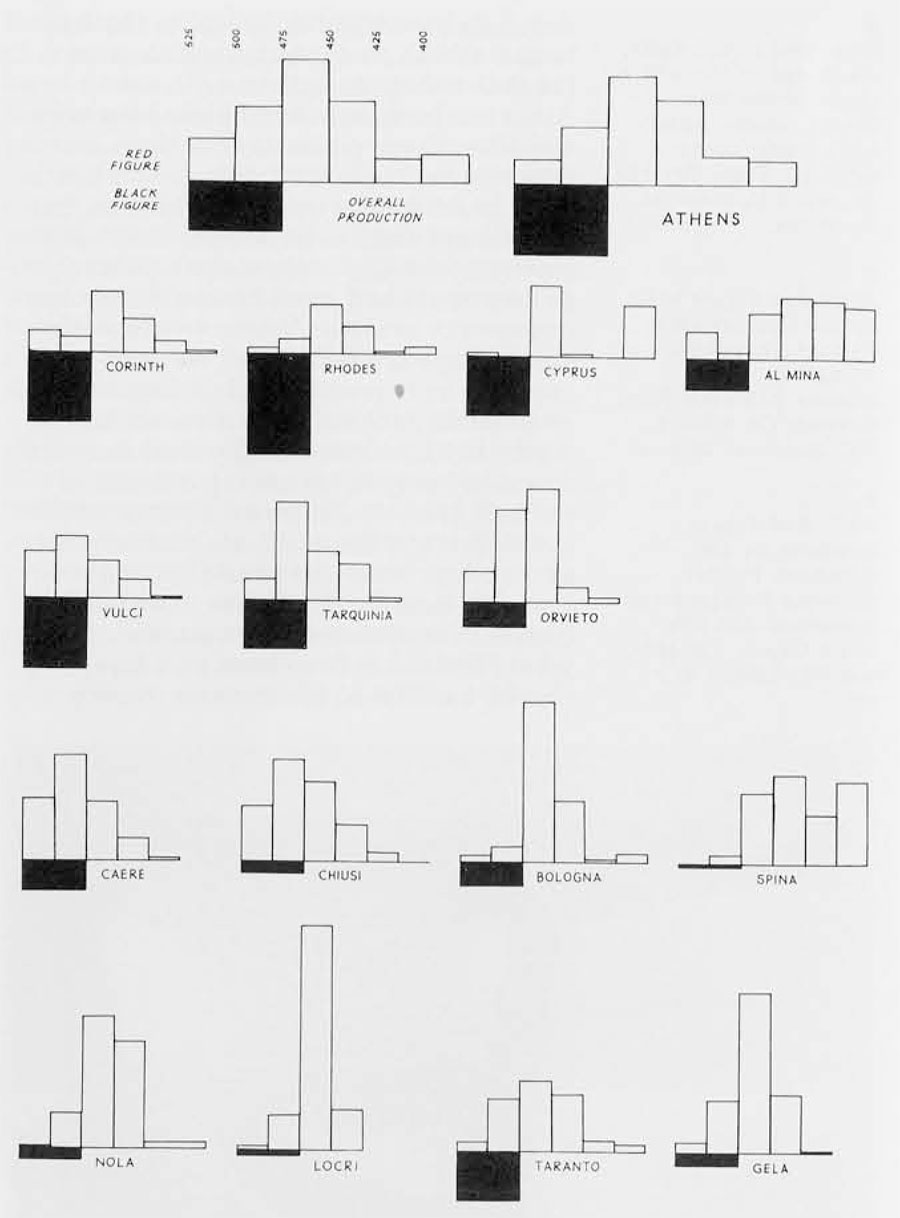
This is not a novel study. Webster was interested in comparable problems in his book and Michael Eisman has made some telling relevant observations. Short of the ideal, global survey of all museums and storerooms, we take our numbers where we can. Our obvious sample is in Beazley’s lists of attributed vases. He was no elitist in this matter, so we have the full range of decorated pottery, and he attributed a high proportion of known vases—higher in Red Figure than in Black Figure, which immediately presents one problem of adjustment, apart from the need to remember the Black Figure lekythoi which he did not list but which appear in Haspels’ work. For dating we can discern styles or groups belonging mainly to each of the quarter centuries from about 525 to 400. (We all accept too readily the tyranny of B.C. dating and I often think we might make fewer historical and art-historical errors if we reverted to dating by Olympiads.) In the first two quarter centuries, the phases of Late Archaic, there are both Black Figure and Red Figure to occupy us and the former cannot readily be divided. The next, Early Classic, may be relatively shorter and confuse our proportions, and it is hard to allow for the tail-end of Black Figure—I have ignored it to help compensate for the possibly shorter period. The `Classic’ and ‘Late 5th Century’ in Beazley’s terms, certainly do not occupy neat quarter centuries, but by this time, and into the 4th century when the production is waning, at least the general trend is clear and we need look only for local deviations. Divisions between periods are vague, the relative lengths of periods are even vaguer—why does it always look so much easier in prehistory? Should we abandon the attempt, or hope that the errors will roughly cancel out each other? At least our failure may encourage others. Further pitfalls we need not dwell upon—mass finds of one date or type, perhaps from a sanctuary, which distort the sample; the excavator’s choice of where to dig, what to throw away, what to publish (less inhibited now than it used to be).
Chart 1 presents the record, period by period, of some of the more promising sites. The numbers of vases included in each case vary considerably and proportions of the whole Athenian import are given for each period. The Black Figure has been spread evenly over the first two periods and the 4th century has been given one column to itself at the end. We are looking for trends rather than absolute proportions, given the limitations of our sources. The first, descriptive table, shows the proportions of apparent overall production, and it is reassuring to observe that the record for finds in Athens itself is so similar. For the rest I offer a few simple observations on what may be significant trends. On Greek sites and in Cyprus the relative lack of interest in Archaic Red Figure is very clear indeed, and, except in Cyprus, the overall number of Athenian vases accepted declines immediately afterwards. The interest in Black Figure perhaps reflects no more than conservatism. After the Archaic there is a big drop in imports to Etruria, and this downward trend persists into the 4th century, though hardly more rapidly than does home production. This fall-away after the Archaic, which is a well-known phenomenon for Etruria whose inimical relations with Greeks in Italy seem to have affected also relations with traders from Greece, was discussed by F. Giudice in an article in Cronache di Archeologia 6 (1977). Perhaps the Etruscans’ declining interest in painted vases was also a factor. The contrast with the Greek sites in South Italy and Sicily is remarkable. Here the imports are sustained or even dramatically rise in the Early Classical period, but then fall away just as dramatically in the more southerly sites, Locri and Gela. There are one or two rogues or special cases to note or attempt to explain: for instance, a virtual plague of early 5th-century cups at Orvieto disturbs its otherwise Etruscan pattern. Bologna’s chart looks odd mainly because the Archaic is more sparsely represented, but the Early Classical boom is notable and we shall return to it; then there is the decline, as in Etruria. But in Spina, where the city develops only after the Archaic, the import is sustained, even growing when compared with overall Athenian production. This is not surprising given its apparent connections with Athens and the importance of the Adriatic route in the 5th century. In the east, Al Mina sustains import throughout, and the relatively much poorer record of Cyprus in the second half of the 5th century surely attests the heavier hand of Persia in the island, probably reducing the conditions for demand rather than positively denying trade.
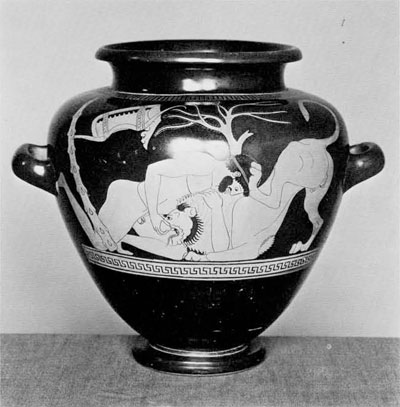
Museum Object Number(s): L-64-185
If these observations include nothing particularly startling or inexplicable we may take comfort that the method is not too misleading and even hope that refinement could offer results of more intimate value. It is a method more profitably applied, on the whole, to the Archaic period, where the competition between different wares can be observed, as, for example, at Tocra.
The second chart, showing the proportions of different, selected, popular shapes received by sites—all Red Figure regardless of period—is less satisfactory in many respects. Also, variables of date and uncharacteristic special finds disturb the patterns far more. Yet this is an interesting subject, and if customers’ demand means anything, the pattern should reveal interests and usages which we would expect to differ in different parts of the Greek world, and certainly between the Greek and barbarian worlds. Professor De Vries has pertinent observations about the lack of oinochoai sent east (except to Anatolia) and suggests that in eastern symposia rhyta performed the function reserved for oinochoai in Greece. This is the sort of thing that an overall survey should draw attention to, and demands explanations from us, but we have to watch the pattern of taste in other areas to be sure that something unusual is happening in any one. The shapes I have chosen are amphorae and pelikai (storage jars, possibly sometimes exported with contents), hydriae (water jars), craters (wine-mixing bowls), oinochoai (pouring jugs), lekythoi (oil flasks), and cups of all types. The sources are again Beazley’s lists, but guided now by the contents of museums the majority, if not all, of whose contents are from the local site. Clearly this is a somewhat less safe way of extracting numbers than from a diligent search through the painter lists, although this I have done for Al Mina and Ampurias, to test two outliers.
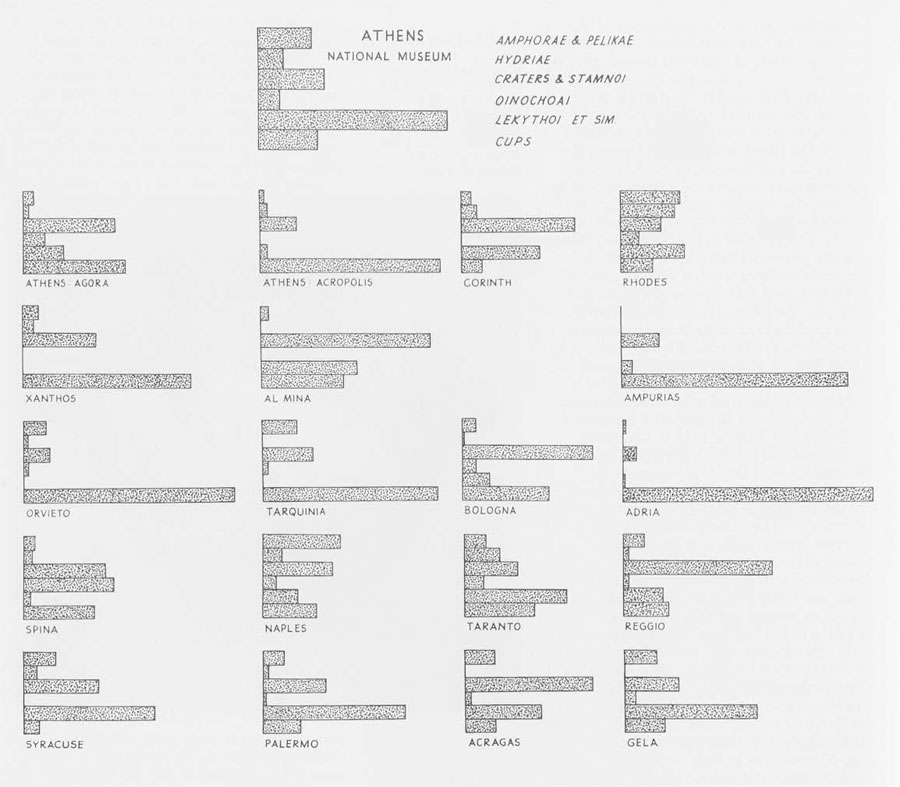
We can draw comparisons between sites easily enough but it is not so easy to Jetermine proportions of overall production of shapes since sources are already heavily weighted in favor of exported wares. The proportions in Athens’ National Museum correspond roughly with those from the two Greek sites and may be near the truth. The figures for the Acropolis and Agora, sanctuary and occupation/ business areas respectively, are distorted in favor of cups which are both useful and popular votives, and against lekythoi which go to cemeteries (we lack accessible data for Athens’ cemeteries and I have omitted the White Ground lekythoi because they are not export vases and would distort comparison with export areas). So this is a shaky start. Etruria will have nothing to do with lekythoi but loves cups, though Bologna, a rogue in the period chart, shows a liking for craters, and a quick check reveals that this is precisely in the Early Classical period, where the site’s import pattern seemed distorted, so this looks like a specialized interest in a limited period (or exceptional luck with cemeteries of this period). On the Adriatic side, Adria is oddly more like Etruria than Spina, where there is a notable interest in craters and oinochoai, barely answered in terms of complete dinner services, by the number of decorated cups available. (The pattern in Etruria is mirrored, incidentally, by the contents of the Florence and Villa Giulia [Rome] Museums.) Sicily, by comparison, accepts few cups, many lekythoi, and the patterns are consistent but for Acragas’ interest in craters. The Greek sites in Italy do without quite so many lekythoi, and all these western Greek sites are better customers for the larger closed vases and craters than is Etruria.
Ampurias in Spain is more like an Etruscan site in its shape-import pattern than a Greek one, except that its imports are growing when the Etruscan are declining—this suggests an extra and possibly revealing dimension to these charts, a combination of records of date and shape, which there is no time to pursue further here. At the other end of the Mediterranean Xanthos, the Lycian capital, is oddly like Etruria again in its tastes but at Al Mina, the Greek trading port on the Syrian coast, things are very different, more “normal” but for the massive import of craters from the “Classic” period on. Both these sites lack oinochoai and if the absence in the East is significant in the manner Professor De Vries suggests, then we must find another explanation for their absence in the West—if indeed explanation is needed since only a few Greek sites (notably Spina) take much interest in the shape at all. It would probably be unwise to press further, other similarities or dissimilarities in the charts.
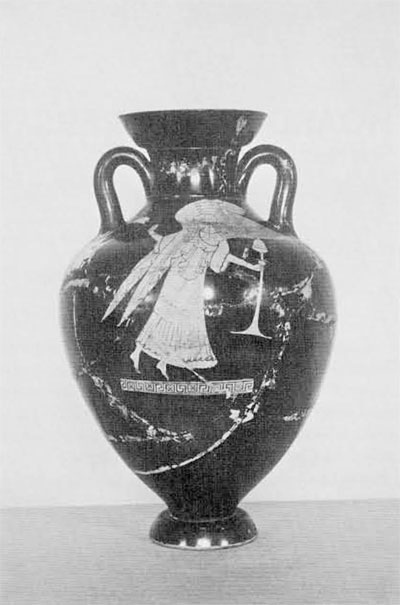
Museum Object Number(s): 31-36-11
Even these summary and inaccurate charts provide many talking points. With a simple calculator, diligence, common sense and that even rarer and most precious of all commodities, time, they could be refined. And with similar studies devoted to subject matter (where we need not feel obliged to find too many significant factors at all) students might yet rescue something of value to the economic historian, or at least to their own understanding of the trade in the Classical world’s most prolific and readily recognizable commodity.
1946 Potter and Painter in Ancient Athens, London.
1956 Attic Black Figure Vase Painters, Oxford.
1963 Attic Red Figure Vase Painters, Oxford.Boardman, John
1968 “Reflections on the Greek Pottery Trade with Tocra,” in Libya in History, ed. F. Gadallah, Tripoli.Boardman, John and J. Hayes
1973 Excavations at Tocra II, London.Cook, R.M.
1959 “Beudeutung der bemalten Keramik für den griechischen Handel,” in Jahrbuch des deutschen archäologischen Instituts, vol. 74: 114-123; on the limitations of Greek pottery evidence.de Vries, Keith
1977 “Attic Pottery in the Achaemenid Empire,” in American Journal of Archaeology, vol. 82: 544-548.Haspels, E.
1936 Attic Black Figured Lekythoi, Paris.Johnson, A. E.
1974 “Trademarks on Greek Vases,” in Greece and Rome, vol. 21: 138-152.
1978 “Lists of Contents: Attic Vases in American Journal of Archaeology, vol. 82: 222-226.
Tiverios, M. A.
1976 Archaiologike Ephemeris: 44-57, for the association of Tyyhenian and Nikosthenic amphoras.
Vallet, G., and F. Villard
1953 Etudies Archéologiques, ed. F. Courbin: 215-216 and 205-217 for a general discussion and economic history.
